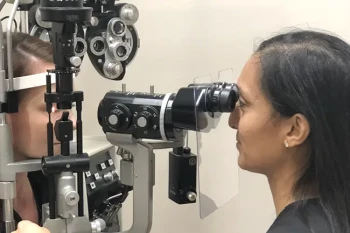
Diabetes is a serious condition that can contribute to a number of eye diseases. Did you know that cataracts is one of them?
What is diabetes?
Diabetes is a condition in which the pancreas does not produce enough, or any, insulin, resulting in an excess of sugar in the blood. There are different variations of this disease, but all can affect the eye. Diabetes can damage specific parts of the eye, including the retina, vitreous, lens, and optic nerve.
What is a cataract?
A cataract is when the lens of the eye becomes cloudy, preventing light rays from clearly passing through and focusing on the retina. It may be mild enough that vision is barely affected, or so severe that no shapes or movements can be seen. Cataracts caused decreased vision, glare while driving at night, and halos around light – all of which can impact day-to-day function.
How can diabetes contribute to cataracts?

The lens of the eye gets oxygen and glucose from the aqueous humor, which is the fluid that fills the front of the eye. If someone doesn’t have control over their glucose levels - such as someone with diabetes - the sugar levels can rise, causing the lens to swell. This in turn can change your glasses prescription. Additionally, the lens has an enzyme that converts glucose into sorbitol. Sorbitol collecting in the lens can affect cells and other proteins, which can make the lens more opaque.
People with diabetes are not just more likely to develop cataracts, but they are likely to develop them at a younger age and have them progress faster than people without diabetes, too.
“Cataracts are two to five times more frequent in patients with diabetes than patients without diabetes and thus can significantly impact visual function in the working population,” CEENTA Ophthalmologist Nikki Saraiya, MD, said.
How can I keep diabetes from affecting my eyes?
If you have diabetes, you should get your eyes checked regularly. If you’ve been diagnosed with diabetes, ask your doctor to refer you to an ophthalmologist. Yearly exams are recommended initially, but if your eye doctor notices any changes, they may ask you to come in more frequently.
You can also keep your eyes healthy by maintaining tight blood sugar, blood pressure, and cholesterol control. This can be done through a combination of a good diet, regular exercise, and taking the medicines your doctor prescribes.
How are cataracts treated?
Cataracts are removed through a 15-minute surgical procedure. Generally, your doctor will make a minor incision in your eye. A small ultrasound probe will break up and remove your cataracts, and a new lens will be placed in your eye.
Diabetic patients who have cataracts removed should still visit their doctor regularly, though.
“Outcomes after cataract surgery may not be as good in patients with diabetes, especially if diabetic retinal disease is already present,” Dr. Saraiya said. “All of these are reasons that a patient with diabetes should have an eye exam at least once a year with an eye doctor.”
This blog is for informational purposes only. For specific medical questions, please consult your physician. Dr. Saraiya practices in our SouthPark, Matthews, and Pineville locations. To make an appointment with her or any of CEENTA’s eye doctors, call 704-295-3000. You can also schedule an appointment online or through myCEENTAchart.
You may also be interested in

Cataracts have more symptoms than just a milky-white appearance. Learn more about some of the lesser-known symptoms of cataracts with cataract surgeon Allison Baker, MD.

Beyond cataract removal, find out if cataract surgery can help with nearsightedness, farsightedness, astigmatism, and night blindness.

After your cataract surgery, follow these post-op steps to ensure that you can see clearly.
Leave a Comment
Back to News

